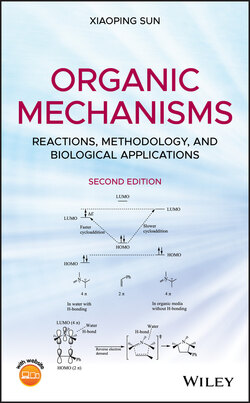Читать книгу Organic Mechanisms - Xiaoping Sun - Страница 12
1 FUNDAMENTAL PRINCIPLES 1.1 REACTION MECHANISMS AND THEIR IMPORTANCE
ОглавлениеThe microscopic steps in a chemical reaction which reflect how the reactant molecules interact (collide) with each other to lead to the formation of the product molecules are defined as mechanism of the reaction. The mechanism of a reaction reveals detailed process of bond breaking in reactants and bond formation in products. It is a microscopic view of a chemical reaction at molecular, atomic, and/or even electronic level.
The structure of most organic compounds is well established by X‐ray crystallography and various spectroscopic methods with the accuracy of measurement in bond distances and angles being the nearest to 0.01 Å and 1°, respectively. Only effective molecular collisions, the collisions of the molecules with sufficient energy that take place in appropriate orientations, lead to chemical reactions. The extent of a chemical reaction (chemical equilibrium) is determined by the changes in thermodynamic state functions including enthalpy (ΔH), entropy (ΔS), and free energy (ΔG). The combination of kinetic and thermodynamic studies, quantum mechanical calculations, and geometry and electronic structure‐based molecular modeling has been employed to reveal mechanisms of various organic chemical reactions.
Reaction mechanisms play very important roles in the study of organic chemistry. The importance of mechanisms not only lies in that they facilitate an understanding of various chemical phenomena but also that mechanisms can provide guidelines for exploring new chemistry and developing new synthetic methods for various useful substances, drugs, and materials. In this regard, mechanistic studies will allow synthetic chemists to vary reaction conditions, temperatures, and proportions of chemical reagents to maximize yields of targeted pure products. For industrial chemists, mechanistic knowledge allows the prediction of new reagents and reaction conditions which may affect desired transformations. It also allows optimization of yields, reducing the costs on raw materials and waste disposals. It provides a tool for the chemists to make reactions occur in their desired ways and manufacture the ideal products. For biochemists and medicinal chemists, the microscopic view of organic reactions can help them better understand how the metabolic processes in living organisms work at molecular level, how diseases affect metabolism, and how to develop appropriate drug molecules to assist or prevent particular biochemical reactions [1].
Overall, the goal of this book is to tie reaction mechanisms, synthetic and green chemistry methodology, and biochemical applications together to form an integrated picture of organic chemistry. While the book emphasizes mechanistic aspects of organic reactions, it is a practical textbook presenting the synthetic perspective about organic reaction mechanisms appealing to senior undergraduate‐level and graduate‐level students. The book provides a useful guide for how to analyze, understand, approach, and solve the problems of organic reactions with the help of mechanistic studies.
In this chapter, fundamental principles that are required for studies and understanding of organic reaction mechanisms are briefly reviewed. These principles include basic theories on chemical kinetics, transition states, thermodynamics, and atomic and molecular orbitals.
